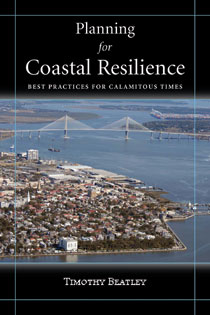"Tim Beatley scouts the frontiers of sustainable development, bringing back examples of progressive practice from the field. He provides a clear-eyed look at emerging efforts by coastal planners struggling to prepare their communities to cope with forecasts of potentially catastrophic impacts of climate change and sea level rise."
David R. Godschalk, FAICP, Emeritus Planning Professor, University of North Carolina
"In this very timely volume, Tim Beatley points out the profound changes that will soon occur along our coasts including sea level rise and increased intensity of storms. In response to these threats, Beatley argues that the principles of coastal resilience afford the way to a sound coastal management future. Case studies and specific examples of resilience approaches make this book a critical addition to the library of anyone concerned with the future of the world's coasts."
Dr. Orrin H. Pilkey, James B. Duke Professor Emeritus, Nicholas School of the Environment
"This is the first book to span the range of issues from socioeconomic vulnerability to green technologies facing coastal managers and planners. Tim Beatley, one of the foremost coastal hazard planners, provides guidelines, a checklist for action, and an overall vision for planning for coastal resilience and climate change. Coastal communities face unprecedented challenges and a possible calamitous future; this is what this book hopes to prevent."
Stephen P. Leatherman, Director, The Laboratory for Coastal Research, Florida International University

